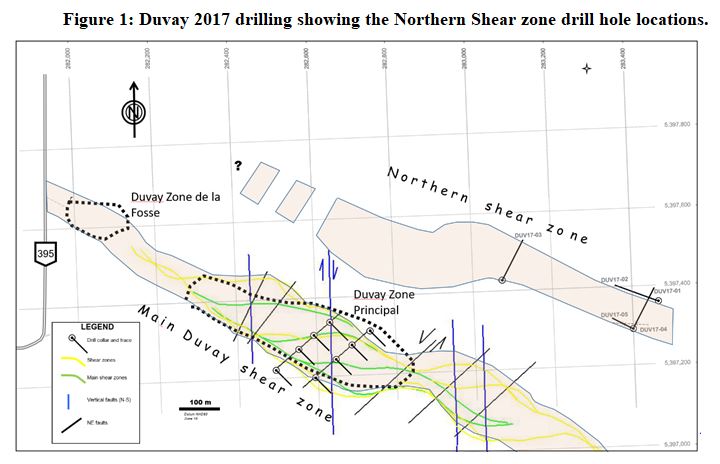Secova and Tres-Or’s Preliminary Drill Results Confirm New Zone on the Duvay Gold Project in Quebec

Secova Metals Corp. (TSXV: SEK, Frankfurt: N4UN, USA: SEKZF) and Tres-Or Resources Ltd. (TSXV: TRS, OTCPK: TRSFF) are pleased to announce gold assay results from the Northern shear zone at the Duvay-Chenier Gold Project (the “Property”), located 15 km northeast of Amos, Quebec.
Secova is currently exploring the Duvay-Chenier Property under an option agreement with Tres-Or to earn a 65% interest by completing expenditures of $3.25 million by December 31st, 2018. Tres-Or is the Operator providing logistical, technical, and geologic services as well as reporting.
The Northern shear zone results are the first results from Secova’s Phase I exploration program. This program comprised 20 drill holes totaling 3207 m, and testing three main target areas.
These three target areas are:
- the Northern shear zone that has a strong induced polarization (IP) chargeability target;
- the Duvay Zone Principal; and
- coincident magnetic/electromagnetic (EM) and structural targets 2 kms northwest of the Zone Principal, near Lake Obalski.
The Company also has collected quartz vein grab samples from the Grenadier gold occurrence which is located 2.5 km southeast of Duvay. The company is waiting for the results of approximately 1,000 more samples from both the drill and grab sample programs.
“We are very pleased with the gold assay results from the northern shear zone as they show mineralization extends 300 to 400 m north of the Duvay Main Shear and Zone Principal where most of the historic work and high gold values are located,” said Laura Lee Duffett, Tres-Or’s President.
The most significant results from the Northern shear zone were obtained in hole DUV17-01, which intersected 5.4 m of gold-bearing deformed quartz vein material as well as substantial concentrations of sulfides and black schist (Table 1).  Hole DUV17-05 was drilled from the same collar location as DUV17-01 and intersected a correlative 4.5 m zone of deformed quartz vein, black schist and minor sulfides (Figure 1). Determination of the true thickness and three-dimensional orientation of the deformed quartz zone requires additional drill intersections.
A second style of gold mineralization was intersected in the northern shear zone by drill hole DUV17-03, 450 m to the west of DUV17-01 (Fig. 1). DUV17-03 intersected locally sulfide-rich pods between 30 and 65 m depth, which carry gold up to 0.42 g/t Au over 3.0 m from 43.50 to 46.50 m depth (Table 2).
This zone was identified as a resistivity target from the IP-resistivity ground geophysical survey (IPower3D) completed by contractor Abitibi Geophysics Inc. over the Duvay area in 2016. The Company is encouraged by confirming gold mineralization over long distances within Duvay’s northern shear zone and anticipates additional drill testing to better define extents and continuity.


